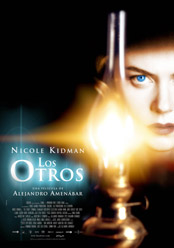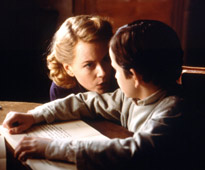| The Others |
| |
 |
France/Spain/USA, 2001. Rated PG-13.
114 minutes.
Cast: Nicole Kidman, Fionnula Flanagan,
Christopher Eccleston, Elaine Cassidy, Eric Sykes, Alakina Mann, James
Bentley
Writer: Alejandro Amenábar
Music: Alejandro Amenábar
Cinematographer: Javier Aguirresarobe
Producers: Fernando Bovaira, José Luis Cuerda, Park Sunmin
Director: Alejandro Amenábar
LINKS
|
 ould
the age of the slasher movie, introduced over two decades ago by Halloween
and rejuvenated a few years ago by Scream and I Know What You Did
Last Summer, finally be drawing to a close? It's doubtful, but there is
certainly a limit to the amount of gore, special effects, and post-modern irony
one can stuff into a horror movie before it collapses under its own weight.
Horror films--most of them--have lost sight of the fact that you can only truly
frighten an audience with what you can convince it is possible and real. Sure,
today's slasher movies deliver jolts; but jolts don't keep you up at night.
ould
the age of the slasher movie, introduced over two decades ago by Halloween
and rejuvenated a few years ago by Scream and I Know What You Did
Last Summer, finally be drawing to a close? It's doubtful, but there is
certainly a limit to the amount of gore, special effects, and post-modern irony
one can stuff into a horror movie before it collapses under its own weight.
Horror films--most of them--have lost sight of the fact that you can only truly
frighten an audience with what you can convince it is possible and real. Sure,
today's slasher movies deliver jolts; but jolts don't keep you up at night.
A different kind of horror movie is re-emerging. In 1999, The Sixth Sense
brought intelligence and character development back to the genre, and became
one of the highest grossing movies of the year. At the same time, The
Blair Witch Project, a movie entirely free of special effects, became
a grass-roots sensation. For all its storytelling faults (attributable to the
fact that it didn't actually have a story), Blair Witch affirmed that
naturalism was far more frightening to audiences than the computer-graphic excesses
of, say, The Haunting. Both films showed
that true fear is evoked by stimulating the mind, and not the senses. They represented
a type of dramatic and thoughtful horror movie not often made since the 1970s--the
age of The Exorcist, Carrie, The Omen, and The Shining.
Taking advantage of the opportunity for naturalism and intelligence thus created,
two chilling films that prioritize human drama above horror-film gimmickry have
been released on the same August weekend: Session 9 and The Others.
Session 9 is a character study set in
a real-life abandoned insane asylum, the most intensely powerful building seen
on film since The Shining. The Others, also a character study,
is the best damn haunted house movie that's literally about a haunted house
that you may ever see.
It's 1945, and World War Two has just ended. Grace (Nicole Kidman) and her
two children inhabit an aging, fog-shrouded mansion on the British island of
Jersey, in the English Channel. Along with the family's new servants (Fionnula
Flanagan, Eric Sykes & Elaine Cassidy), we learn that Grace's husband (Christopher
Eccleston) is missing in action (presumed dead) and that the kids (Alakina Mann
& James Bentley) suffer from photosensitivity, a condition characterized by
extreme sensitivity to sunlight. It can cause their skin to break out in a rash
and even kill them. The children, Anne and Nicholas, are therefore imprisoned
in the house, which has lacked electricity, a telephone, or anything else "that
makes a racket," as Grace puts it, since the German occupation of the island,
and that's just the way she likes it. The mansion is their universe. In haunted
house movies, we typically wonder why the characters don't get the hell out
as soon as the otherworldly shenanigans begin. That's not an option here.
Deeply faithful in God and harboring an antipathy to "fantasy," Grace runs
a tightly regimented household. To prevent accidents with sunlight, Grace insists
that no door be opened without the previous one being closed and locked. But
something in the house is not obeying her rules. The children notice the presence
of "others" first, but Grace refuses to believe it. Her response is to scream
at servants and attempt to assert control more strongly.
AboutFilm.Com
The Big Picture
|
| Alison |
-
|
| Carlo |
A
|
| Claudia |
B+
|
| Dana |
-
|
| Jeff |
B+
|
| ratings explained |
Like Session 9, The Others is a portrait of the human mind--Grace's
mind, to be exact. The Others is not just about what the mind finds scary,
but how the mind deals with stress, what it abhors and what it cannot, or will
not, understand. The entire house is a metaphor, writ large, for Grace. Her
insistence on keeping the house shielded and in darkness, ostensibly to protect
her children, is symbolic of how she chooses to relate to the world, and at
odds with her stated adherence to modern reason. She and the children have been
hiding in the house for so long that when the house and possibly the lives of
her children slip from her control, so does her mind. The house, the presence--or
not--of ghosts, and all the horror trappings in the movie are a vehicle for
studying Grace and her children. Kidman deserves an Oscar nomination for her
intricate performance here far more than for her impression of a sickly Jessica
Rabbit in Moulin Rouge.
Enhancing the realism, the lighting all appears to be natural--usually candlelight--and
there is a restraint on special effects. Only two obvious effects are in the
film. Instead, writer/director Alejandro Amenábar relies on mood and the power
of suggestion to create creepiness and fear, and he always maintains his focus
on the characters. Granted, Amenábar puts you through the obligatory jumps (and
quite effectively, too), but they would not be so effective had the film not
drawn you close first.
In terms of basic plot elements, The Others is obviously not the most
original film made. It's a movie about a haunted house--an idea probably as
old as the first thatched mudhut ever built. But even if the twists and turns
do not surprise you, the broad outlines of the story are not the source of the
film's mastery. It lies in the execution and the complex thematic content, which
enriches every dimension of the story. The Others is more masterful and
assured even than its most obvious inspirations. It is a beautiful film.
Review
© August 2001 by AboutFilm.Com and the author.
Images © 2001 Dimension Films. All Rights Reserved.


